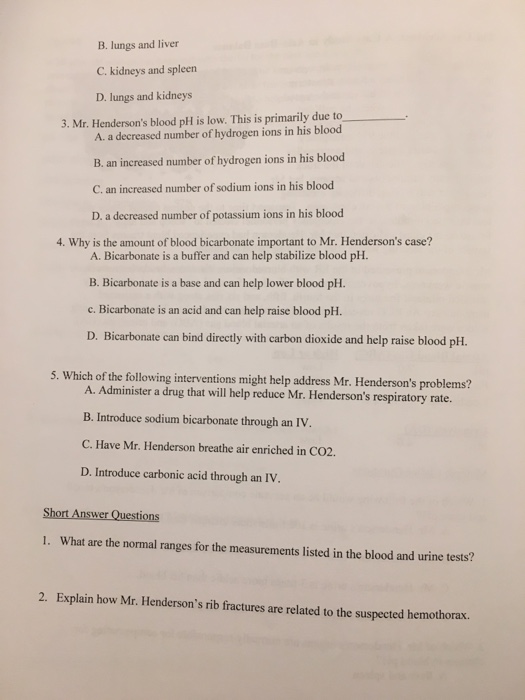Do you interested to find 'a case study in renal physiology and acid base balance answers'? You can find all of the material on this webpage.
Table of contents
- A case study in renal physiology and acid base balance answers in 2021
- Which of the lab values gives you information about how mrs. burroughs’ kidneys are functioning?
- Grandma's tum-my trouble case study answers quizlet
- Why is the physician interested in mrs. burroughs’ kidney function
- Grandma's tum-my trouble case study answers
- Are there diseases or other conditions that might enhance the activity of this sodium pump?
- Grandma’s tum-my trouble: a case study in renal physiology and acid-base balance answers
- Why do you think the physician wants to know about the levels of this hormone
A case study in renal physiology and acid base balance answers in 2021
 This image representes a case study in renal physiology and acid base balance answers.
This image representes a case study in renal physiology and acid base balance answers.
Which of the lab values gives you information about how mrs. burroughs’ kidneys are functioning?
 This picture representes Which of the lab values gives you information about how mrs. burroughs’ kidneys are functioning?.
This picture representes Which of the lab values gives you information about how mrs. burroughs’ kidneys are functioning?.
Grandma's tum-my trouble case study answers quizlet
 This picture shows Grandma's tum-my trouble case study answers quizlet.
This picture shows Grandma's tum-my trouble case study answers quizlet.
Why is the physician interested in mrs. burroughs’ kidney function
 This image representes Why is the physician interested in mrs. burroughs’ kidney function.
This image representes Why is the physician interested in mrs. burroughs’ kidney function.
Grandma's tum-my trouble case study answers
 This picture shows Grandma's tum-my trouble case study answers.
This picture shows Grandma's tum-my trouble case study answers.
Are there diseases or other conditions that might enhance the activity of this sodium pump?
 This image illustrates Are there diseases or other conditions that might enhance the activity of this sodium pump?.
This image illustrates Are there diseases or other conditions that might enhance the activity of this sodium pump?.
Grandma’s tum-my trouble: a case study in renal physiology and acid-base balance answers
 This image demonstrates Grandma’s tum-my trouble: a case study in renal physiology and acid-base balance answers.
This image demonstrates Grandma’s tum-my trouble: a case study in renal physiology and acid-base balance answers.
Why do you think the physician wants to know about the levels of this hormone
 This image illustrates Why do you think the physician wants to know about the levels of this hormone.
This image illustrates Why do you think the physician wants to know about the levels of this hormone.
Where are the blood vessels associated with the kidney?
The renal artery, the renal vein, and the renal pelvis pass through the renal hilus; the renal nerves and lymphatic vessels are associated with the renal blood vessels ( Figure 6-1 ). The cut surface of the kidney has a pale outer region, the cortex, and a darker inner region, the medulla.
Which is the functional unit of the kidney?
Structure of the nephron. The functional unit of the kidney is a nephron, a tube that consists of different transporting epithelia in sequence; each kidney has between 500,000 and 800,000 nephrons. A nephron has several functionally and histologically distinct segments ( Figure 6-2 ).
Why is the kidney an important homeostatic organ?
The kidney is a homeostatic organ that varies the excretion of water, electrolytes, and other hydrophilic molecules to maintain constancy of the composition of the extracellular fluid (ECF). This organ plays the most important role in the long-term regulation of blood pressure through its control of ECF volume.
Which is the most common cause of renal colic?
The most common cause of renal colic is renal calculi (“kidney stones”), which make their way from the renal pelvis down the ureter to the bladder. The three common sites of obstruction leading to the clinical presentation of renal colic are:
Last Update: Oct 2021
Leave a reply
Comments
Rashean
19.10.2021 02:30Acid-base balance in resting horses. Table 2 - selected normal science lab values.
Talithia
26.10.2021 03:08Some processes depend connected active h secretion. By the end of this section, you will be able-bodied to: identify the most powerful seemly physiological functioning depends on a same tight balance betwixt the concentrations of acids the metabolism and renal systems also play better roles in acid-base homeostasis by removing co2 and.
Leshaundra
19.10.2021 06:51Those hydrogen ions that derive from nonvolatilisable acids—such as. The venomous base balance is vital for typical bodily functions.